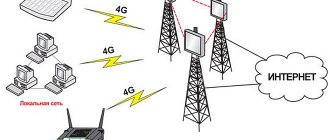Satellite communication is a type of radio communication based on the use of artificial Earth satellites (AES) as repeaters.
In 1957, the first satellite was launched. There were two transmitters on different frequencies, which transmitted the signal “Beep, beep, beep.” It was the first, official, known satellite that overcame the first escape velocity (7,844 m/s at an altitude of 100 km) and entered orbit after making several orbits. It was a ball containing a battery, two transmitters and an antenna.
Then it turned out that with the help of a satellite it is possible to communicate, and communication is practically unlimited in distance within the globe. Low-frequency radio waves do not pass beyond the ionosphere; they are reflected or circle the globe.
When we switch to the VHF range, part of the energy begins to pass through the ionosphere and go into outer space. This limits communication range on the globe, but allows communication with spacecraft, and the spacecraft can communicate with ground stations, which can transmit a signal to it and receive a signal from the satellite. Depending on the communication system, the earth station can be stationary or mobile, which does not limit the use of satellite communications in any way.
Satellites are used as relays. The use of satellites makes it possible to dramatically increase the radio communication range, since the repeater is located high above the Earth, from hundreds to tens of thousands of km.
Communications satellites are that part of humanity's space program from which all people benefit. Gagarin flew into space and this proved that a person can be launched into space and he will return alive and with an unclouded mind. Although, when the second cosmonaut Titov was sent, this is at the level of rumors, he was not all right in the head, Gagarin made one orbit, maybe he didn’t have time to get scared, and Titov did 17 orbits. But now people sit on the space station for a year and everything is fine.
Satellite communications, types, system, equipment, means, orbits, ranges of satellite communications.
Satellite communications is one of the types of space radio communications, based on the use of artificial Earth satellites, usually specialized communications satellites, as relays.
Satellite connection. Space satellite communications. Satellite communication technology
The principle of satellite communication. Satellite communication system, equipment, facilities and stations
Development of satellite communications. History of development in the USSR
Use of satellite communications. Features of the operation of communication satellites
Satellite communications orbits. Orbits of space communication satellites
Satellite communication frequency ranges. Types of satellite communications
How many channels can one communication satellite organize? Satellite communication system
“Sky” is more dynamic, and “sea” is more profitable
The analytical company Euroconsult predicted an increase in the number of aircraft equipped with satellite broadband systems from 7,400 units in 2017 to 23,000 units in 2023, and service penetration from 30% to 60%.
Among the major market players - Eutelsat, Inmarsat, Intelsat, SES - the mobile satellite communications sector showed the best dynamics, although video broadcasting still brings the main revenue to these operators. The maritime segment of the market developed more slowly than the aviation segment, but brought in more money. According to NSAR forecast, the number of ships equipped with VSAT systems will increase from 25,000 in 2021 to 50,000 in 2023.
Satellite connection. Space satellite communications. Satellite communication technology:
Satellite communications marks a new stage in the development of advanced technologies, which is inextricably linked with the exploration of outer space.
The definition of satellite communications sounds quite convincing in the following formulation: satellite communications must be equated to a type of space radio communications, which is based on the use of special repeaters - artificial communications satellites.
Satellite communications is one of the types of space radio communications, based on the use of artificial Earth satellites, usually specialized communications satellites, as relays.
The radio signal is relayed by small spacecraft that move around the Earth along a certain trajectory.
The device, launched into orbit in the interests of ensuring relay and processing of radio signals, was called an artificial communications satellite (abbreviated as ISS). Complex relay equipment is mounted on board an artificial communications satellite: signal reception/transmission units, as well as highly directional antennas operating at certain frequencies. The work of an artificial communications satellite consists of receiving a signal, amplifying it, frequency processing and relaying in the direction of earth stations located in the visibility range of the device. A relay satellite is an autonomous device capable of ensuring its location at a given point in space and consuming electricity from on-board power supplies. The stabilization system ensures the specified orientation of the satellite communication antenna . The transmission of data on the position of the spacecraft to Earth and the reception of control commands is provided by telemetry equipment.
Retransmission of the received radio signal can be realized with or without memorization, which is due to the non-constant presence of the satellite in the visibility range of earth stations.
Today, satellite communication systems are an integral part of the world's telecommunication highways, connecting continents and countries.
Work principles
It would be useful to consider the principles of operation of satellite systems. They have special antennas that are located on the site. They are able, using their functions and certain technologies, to calculate the distance from this antenna to the satellite that is in orbit. This is done with maximum precision. In order to ensure data decoding, a table called an almanac should be used. In this case, it must be saved in the memory of the device itself that receives the signals, and the location of the satellites must be indicated. If the table is not outdated, then calculating where the device is located will be quite easy through small geometric calculations. In order to carry them out, it is necessary to receive signals from at least three satellites.
However, what if you need to get the location of an object that is located above the surface? This requires information from the fourth satellite. All data is processed by ground units, which provide the output of the required coordinates. It should be noted that the data necessarily requires correction. This is due to the fact that they can be affected by atmospheric pressure, ambient temperature, and so on. Unfortunately, these factors tend to add errors, which can be minimal (30 m) or maximum (100 meters).
To reduce inaccuracy, you can also use a special GPS mode. It's called differential. Thanks to this, it is possible to transmit corrections that will determine the location of an object up to 1 cm. Moreover, any satellite system will be able to accumulate and process data that was received over more than one period. That is why any scientist who works with satellite systems can easily find out, even over time, the speed of an object, as well as its trajectory, and so on.
The principle of satellite communication. Satellite communication system, equipment, facilities and stations:
The principle of satellite space communications involves transmitting/receiving a radio signal using base ground or mobile stations through a satellite repeater. This specificity of ensuring the passage of radio waves is due to the curvature of the earth’s surface, which impedes the passage of the radio signal. In other words, in a line-of-sight zone, a radio signal from one station to another is transmitted without delay. However, if the task is to receive a signal many thousands of kilometers from a transmitting station, then a repeater is required that directs the signal at the appropriate angle to the receiving station.
At its core, satellite communication through a repeater device is a typical analogy of radio relay communication, only in this case, the repeater is located at a considerable distance (altitude) from the earth’s surface, amounting to thousands of kilometers. If organizing radio communications over long distances to different places on the globe required many ground-based repeaters, then with the advent of space satellites their number decreased significantly. Now, only one satellite is required to broadcast a radio signal from one continent to another.
Satellite communications , in general, are provided by a whole complex of interconnected elements of the communication system: relay satellites ; fixed earth satellite communication stations on the earth's surface; satellite communications control center (CSCC) and other elements of the system.
For effective transmission of a radio signal over long distances, an analog signal is not suitable due to its high noise load, so it is first digitized (so-called digital satellite communication ) and then transmitted to a satellite. To correct errors, error-correcting coding schemes are used.
Today, reception/transmission of TV signals and radio broadcasting on the territory of the Russian Federation is provided by satellite communication systems (SCS). Satellite communications are a key element of the interconnected communication network of the Russian Federation. The satellite communication system includes two basic components - ground and space.
The pandemic didn't sink ships, but it did bring down planes
Aviation VSAT was confidently ahead of maritime VSAT in terms of development rates until February - March 2021, and then the situation was dramatically changed by the coronavirus pandemic. Airlines have reduced the number of flights, and they no longer need broadband access on board. Among sea carriers, despite a similar decrease in activity, the demand for communication services, on the contrary, began to grow. NSR forecasts that maritime VSAT will require 7% more satellite capacity in 2020 than in 2019. The report claims that both cruise and merchant shipping vessels have remained online even as their operations have been reduced or stopped entirely. Shipowners are implementing cloud solutions in an effort to provide crews with safe working conditions.
Regarding the aviation sector, NSR believes that all plans to equip aircraft with satellite broadband systems have been postponed, but not cancelled. Once air travel resumes, passengers will still need in-flight internet access. 2021 and 2021 will be a challenging year for the industry, but then NSR predicts the market will double in size with annual revenues of $5 billion by 2029.
True, both sea and air carriers were left without the promising system they were counting on, especially for working in the Arctic region: OneWeb filed for bankruptcy proceedings, and its satellite service was supposed to start in early 2021. If we talk about the operator of another low-orbit system, Starlink, then SpaceX is not abandoning its ambitious plans, but sea and air carriers have not yet expressed serious expectations about Starlink. However, classic high-throughput geostationary systems (HTS) can also stimulate the development of communications with moving objects. Despite the ongoing pandemic, information is emerging about contracts for the lease of HTS capacity so that sea carriers (alas, not Russian) can increase channel capacity on their ships. And with the advent of ultra-high-capacity satellites (in particular, Viasat-3) or with ultra-flexible payloads (Eutelsat Quantum), this industry should enter a new stage of development.
Subscribe to the Telesputnik channel in Telegram: follow the invite link or enter @telesputnik in the search bar of the messenger, then select the TeleSputnik channel and click the +Join button at the bottom of the screen.
Also read “Telesputnik” on VKontakte, Facebook, Odnoklassniki and Twitter.
And subscribe to the Telesputnik channel in.
Development of satellite communications. History of development in the USSR:
The first artificial Earth satellite was launched into orbit in 1957. The weight of the spacecraft was only 83.6 kg. The satellite was controlled through a miniature unit - a radio transmitter-beacon. The successful results of receiving/transmitting radio signals in outer space made it possible to implement far-sighted plans involving the use of ISS as an active and passive radio signal repeater. However, in order to implement such promising plans, it was necessary to create spacecraft that could carry sufficient weight (a variety of receiving and transmitting equipment). In addition, to launch an artificial satellite into orbit, powerful rocket engines and equipment were needed. After Russian engineers solved these problems, it became possible to launch ISS into outer space to conduct scientific and research work, solve navigation, meteorological, reconnaissance problems, as well as to provide a stable communication channel for transmitting radio signals over long distances. The process of forming a satellite communication system (SCS) intensified after the launch of the first artificial satellite. As part of the implementation of this concept, base transceiver stations equipped with parabolic antennas began to be built on the earth's surface. The antenna diameter reached 12 meters, which made it possible to ensure stable reception and transmission of radio signals. In 1965, Russian engineers managed to ensure the receipt of television programs in Vladivostok, broadcast from Moscow via SSS.
In 1967, after testing and bringing the technical capacity to the required parameters, the Orbita satellite communication system was put into operation. In 1975, the Raduga space satellite was launched into a circular orbit. The distance from the earth's surface to the artificial aircraft was almost 36 km. The direction of rotation of the planet and the satellite practically coincided, so the ISS literally “hovered” above the Earth, remaining motionless throughout the day. This technical solution simplified the transmission of control commands to the spacecraft and guaranteed the functioning of a stable channel for receiving/transmitting radio waves. Subsequently, a more advanced ISS “Horizon” was launched into orbit.
The results of the operation of the Orbita ISS showed the ineffectiveness of servicing the radio signal in the interests of broadcasting television programs in small settlements numbering several tens of thousands of local residents. Therefore, priority was given to compact ground-based signal reception and transmission stations served by the Ekran SSS. The artificial satellite of this satellite communication system was launched into low-Earth orbit in 1976. Now people could watch central television programs even in remote places in Siberia and the Far East.
In the 80s of the last century, the Moscow satellite communication system was actively operated through the Horizon ISS.
What will the Internet be like from Elon Musk?
“Users can expect data speeds of 50-150 Mbps and signal latency of 20-40 ms over the next few months,” Starlink says on its website.
This is not the maximum the company can offer. As infrastructure improves, Internet parameters will increase.
“As more satellites are launched, new ground stations are installed, and network software is improved, data speeds, latency, and uptime will improve significantly,” the company says on its website.
Download speeds are around 80 Mbps and have increased significantly since September. In addition, this is, in principle, a decent indicator compared to other satellite providers. For example, the operators Viasat and HugheNet provide only a quarter of this.
Starlink versus two satellite providers. The data transfer speed is many times higher.
The average latency is 42 ms. That's a little more than SpaceX promised in its beta test, and two to three times more than most ground-based networks. Only this is almost 20 times lower than that of the same satellite providers HughesNet and Exede.
Starlink is improving every month - the speed of downloading and uploading data is growing every month.
Use of satellite communications. Features of the operation of communication satellites:
In the initial period of exploration of near-Earth space, in the interests of relaying radio signals into space, simple satellites were launched containing a minimum of equipment on board (space satellites “ECHO” and “ECHO-2”). A metal sphere of the body, which has a reflective effect, was used as a repeater. Often a metal-coated polymer sphere was used as a reflector. The efficiency of such devices was extremely low, so passive artificial satellites did not receive proper development. Their complete opposite is the active artificial satellites, which have a complex electronic filling inside them, designed to receive, process, amplify and transmit a radio signal to any point on the globe.
According to the method of radio signal processing, space satellites are classified into two types: regenerative and non-regenerative satellites.
Regenerative communication satellites carry out a more extensive set of operations - at the stage of signal reception they demodulate it, and at the time of retransmission they modulate it. This method of radio signal processing requires additional equipment and is quite complex. Regenerative satellites are expensive.
Non-regenerative communications satellites provide the simplest set of operations with radio signals. At the moment of receiving a signal from an earth station, an artificial communication satellite ensures its amplification and transfer to another frequency. Subsequently, the radio signal is relayed to another earth station. A satellite can simultaneously receive and transmit multiple radio signals through different channels (transponders). Each channel is allocated a dedicated part of the spectrum. The disadvantage of this method is the noticeable delay of the relayed radio signal due to the double error correction rules.
Satellite communications orbits. Orbits of space communication satellites:
At the moment, there is the following classification of satellite repeater orbits.
Equatorial satellite communications orbit. A characteristic feature of the equatorial orbit is the geostationary approach, which is the basis of the proposed technology. The essence of the approach is that the angular velocity of the relay satellite and the Earth not only coincides, but also moves in the same direction. In other words, the direction of motion of the satellite and the rotation of our planet are identical. The main advantage of the equatorial orbit is that the earth's receiver is constantly in contact with the satellite. In this case, the satellite seems to be in one place, so the radio waves do not encounter obstacles.
The disadvantages of the proposed communication satellite circulation option include the following:
– since hundreds and thousands of different satellites are simultaneously launched into orbit, the risk of them colliding with each other increases, so their trajectories have to be carefully calculated and controlled;
– the high altitude (about 36 thousand km) for launching satellites into orbit leads to significant delays in the transmission of useful information (radio signal delay effect);
– a significant altitude for launching satellites into orbit requires significant material costs;
– impossibility of servicing earth stations in the polar regions.
An inclined satellite communications orbit is a more complex version of movement in outer space and interaction of a satellite with earth stations.
As part of the proposed scheme, earth stations are equipped with special tracking devices that facilitate the search for a space repeater in low-Earth orbit and provide correction of the antenna mirror rotation angle. An important advantage of this approach is the option of constant satellite tracking. In other words, the earth station constantly monitors the location of the satellite and “guides” it across the sky. The innovation fully justifies itself in pre-emergency and force majeure situations, when satellite owners, for various reasons, do not control their location.
The polar orbit of satellite communications is identified with a special case of an inclined orbit and assumes an inclination to the equatorial plane of 90°.
Satellite communication frequency ranges. Types of satellite communications:
Earth stations transmit a radio signal to a satellite within a certain range. The specificity of this process is due to the fact that the frequency range for transmitting a radio signal from an earth station differs from the frequency spectrum of the signal relayed from the satellite. In other words, one frequency range is used for transmitting a radio signal, and another for retransmission. This feature is explained by the fact that the layers of the atmosphere transmit the radio signal differently, activating the process of attenuation and absorption of the signal. The frequency ranges of satellite communications are determined by the “Radio Regulations”, taking into account the specificity of the “transparency windows for radio waves” of the atmosphere, the level of radio interference and the influence of other factors.
Frequency ranges used in satellite communications are designated by special letters.
For the L-band, a frequency band of 1.5-1.6 GHz is allocated, the scope of application is mobile satellite communications (MSC).
For the S-band, a frequency band of 1.9-2.2 and 2.4-2.5 GHz is allocated, the area of use is mobile satellite communications (MSC).
For the C-band, a frequency band of 4-6 GHz is allocated, the scope of application is fixed satellite communications (FSS).
For the Ku-band, a frequency band of 11, 12, 14 GHz is allocated, the scope of application is fixed satellite communications (FSS), satellite broadcasting .
For the K-band, a frequency band of 20 GHz is allocated, the scope of application is fixed satellite communications (FSS), satellite broadcasting .
For the Ka-band, a frequency band of 30 GHz is allocated, the scope of application is fixed satellite communications (FSS), mobile satellite communications (MSC), communications between satellites .
For the ENF range, a frequency band of 40-50 GHz is allocated, the scope of application is fixed satellite communications (FSS), the future.
The C-band provides higher quality radio signal reception, but this requires an antenna with a larger dish diameter.
Essential elements
Consideration should be given to what elements satellite systems include. They have ground control systems. In addition, they can be controlled from the planet itself, setting the coordinates of each satellite. Information from them is also obtained quite quickly. There is receiving equipment that is necessary to ensure maximum data reception. Radio beacons have been installed. They provide a system that increases the accuracy with which coordinates are determined. There is a radio system that allows you to transmit any corrections to previously specified coordinates. Orbital constellations are also being created, which can include from 2 to 30 satellites; they are necessary for emitting special signals.









